A Guide for Architectural Design
Eco-Friendly Building Trends: Shaping a Sustainable Future
In today's architectural and construction landscapes, the shift towards sustainability is not just a trend—it's an essential transition. At TAS Design, we are deeply committed to integrating eco-friendly practices into our projects. This dedication not only reflects our passion for innovative architecture but also our responsibility towards the environment. The following trends are at the forefront of creating buildings that are as kind to the planet as they are to the people living and working in them.

Green Roofing Systems
Green roofs are not only aesthetically pleasing but also play a critical role in enhancing biodiversity, insulating buildings, and managing stormwater. By incorporating vegetation atop buildings, urban areas can combat the heat island effect, significantly reducing the need for air conditioning during the warmer months. At TAS Design, we consider green roofing an essential component of modern ecological architecture, offering both environmental benefits and energy savings.

Technological Advances in Green Roofing
The integration of technology in green roofing has led to significant advancements, including smart irrigation systems that optimize water use and solar panels that complement the green roof's energy savings. These technologies ensure that the ecological footprint of buildings is minimized while maximizing their energy efficiency. TAS Design leverages such innovations, aligning with our commitment to sustainability and showcasing the potential of integrating nature with modern architecture.

The Benefits of Urban Green Spaces
Expanding on the concept of green roofing, these living systems offer a unique opportunity to reintroduce nature into urban environments. Beyond their ability to regulate building temperatures, green roofs serve as crucial habitats for local wildlife, including pollinators and bird species, thereby contributing to urban biodiversity. Furthermore, they can transform unused roof spaces into vibrant community gardens or serene green retreats, improving the mental and physical health of urban residents.
Energy-Efficient Design
Energy efficiency is a cornerstone of sustainable architecture. Techniques such as passive solar design, where buildings are oriented and designed to maximize natural light and heat, significantly reduce energy consumption. Incorporating high-quality insulation, energy-efficient windows, and LED lighting further enhances a building's energy performance. TAS Design prioritizes these elements, integrating smart technology that allows buildings to adapt to their environments, reducing the need for artificial heating, cooling, and lighting.
Passive Design Principles
Delving deeper into energy efficiency, passive design principles extend beyond just the orientation and insulation of buildings. Considerations such as thermal mass, which involves using materials that can absorb and store heat energy, play a crucial role in maintaining comfortable indoor temperatures year-round. By carefully selecting and placing materials, we can create buildings that naturally maintain their warmth in the winter and stay cool in the summer, drastically reducing reliance on mechanical heating and cooling systems.

Smart Home Technologies
In the realm of energy-efficient design, smart home technologies have become increasingly important. Systems that allow for the remote control of lighting, heating, and cooling can significantly enhance a building's energy efficiency. These technologies not only provide convenience but also ensure that energy is used only when needed, further reducing the ecological footprint of our homes and buildings. TAS Design incorporates these smart systems, offering clients both enhanced comfort and a step towards a more sustainable future.
Sustainable Materials
The choice of materials plays a pivotal role in the environmental impact of a building. Recycled, reclaimed, and sustainably sourced materials are becoming increasingly popular in the construction industry. From bamboo flooring to recycled steel beams, these materials reduce the carbon footprint of buildings. Moreover, TAS Design emphasizes the importance of materials that not only support sustainability but also ensure durability and longevity, reducing the need for future replacements and renovations.
Lifecycle Assessment
When selecting materials for sustainable construction, the lifecycle assessment (LCA) becomes a critical tool. This process evaluates the environmental impact of materials from their extraction and manufacturing to their use and eventual disposal. By favoring materials with a low environmental impact across their lifecycle, TAS Design ensures that each project not only minimizes immediate ecological footprints but also contributes to long-term sustainability.

Innovations in Material Technology
Recent innovations in material technology have introduced exciting possibilities for sustainable construction. For example, self-healing concrete incorporates bacteria that can fill cracks as they form, extending the material's lifespan and reducing maintenance needs. Additionally, new forms of insulation made from recycled materials offer superior thermal performance without the environmental drawbacks of traditional options. By staying at the forefront of these technological advancements, TAS Design is able to offer cutting-edge solutions that are both innovative and eco-friendly.
Water Conservation Features
Water conservation is another critical aspect of eco-friendly building trends. Systems such as rainwater harvesting and greywater recycling significantly reduce the demand for potable water in buildings. Low-flow fixtures and water-efficient landscaping are also key strategies in minimizing water usage. By implementing these features, TAS Design projects aim to achieve a harmonious balance between human needs and environmental preservation.

Water-Sensitive Urban Design (WSUD)
Water-sensitive urban design (WSUD) is an approach that integrates water conservation into the broader urban landscape. This includes the creation of permeable surfaces to enhance groundwater recharge and the use of native plant species that require less water. Such designs not only conserve water but also manage stormwater more effectively, reducing urban flooding and pollution. By incorporating WSUD principles, TAS Design is helping to create urban environments that are more resilient and sustainable.
Rainwater Harvesting and Greywater Recycling
Expanding on water conservation, rainwater harvesting systems collect and store rainwater for non-potable uses such as irrigation and flushing toilets, while greywater recycling systems reuse water from sinks, showers, and washing machines. These systems not only reduce the demand for fresh water but also lessen the strain on municipal water systems and local ecosystems. Integrating these systems into our designs, TAS Design is contributing to a sustainable water future.
Biophilic Design
Biophilic design is an innovative approach that seeks to connect building occupants more closely with nature. Incorporating elements such as natural lighting, ventilation, indoor plants, and materials that mimic natural textures can improve air quality, enhance well-being, and increase productivity. TAS Design integrates biophilic principles to create spaces that inspire, heal, and energize, fostering a deeper connection between humans and their natural environment.

The Role of Technology in Biophilic Design
The integration of technology with biophilic design opens new possibilities for bringing nature into built environments. For instance, advanced ventilation systems can mimic natural breezes, while dynamic lighting systems replicate the natural light patterns of the sun, adjusting to the time of day to maintain a connection with the natural world.
Enhancing Well-being with Nature
Further exploring biophilic design, research has shown that spaces that incorporate natural elements can have profound impacts on health and well-being. Natural light has been linked to improved mood and productivity, while the presence of plants can reduce stress and improve air quality. By designing spaces that are not just functional but also nurturing, TAS Design is creating environments where people can thrive.
Contact Us
Office Hours
Social Media
Mon- Fri 8 am - 5 pm
Sat, Sun- Closed except by appointment





Contact Us
1 540-302-2593
2507 Bluff Road
Roanoke VA 24014
Office Hours
Mon- Fri 8 am - 5 pm
Sat, Sun- Closed except by appointment












